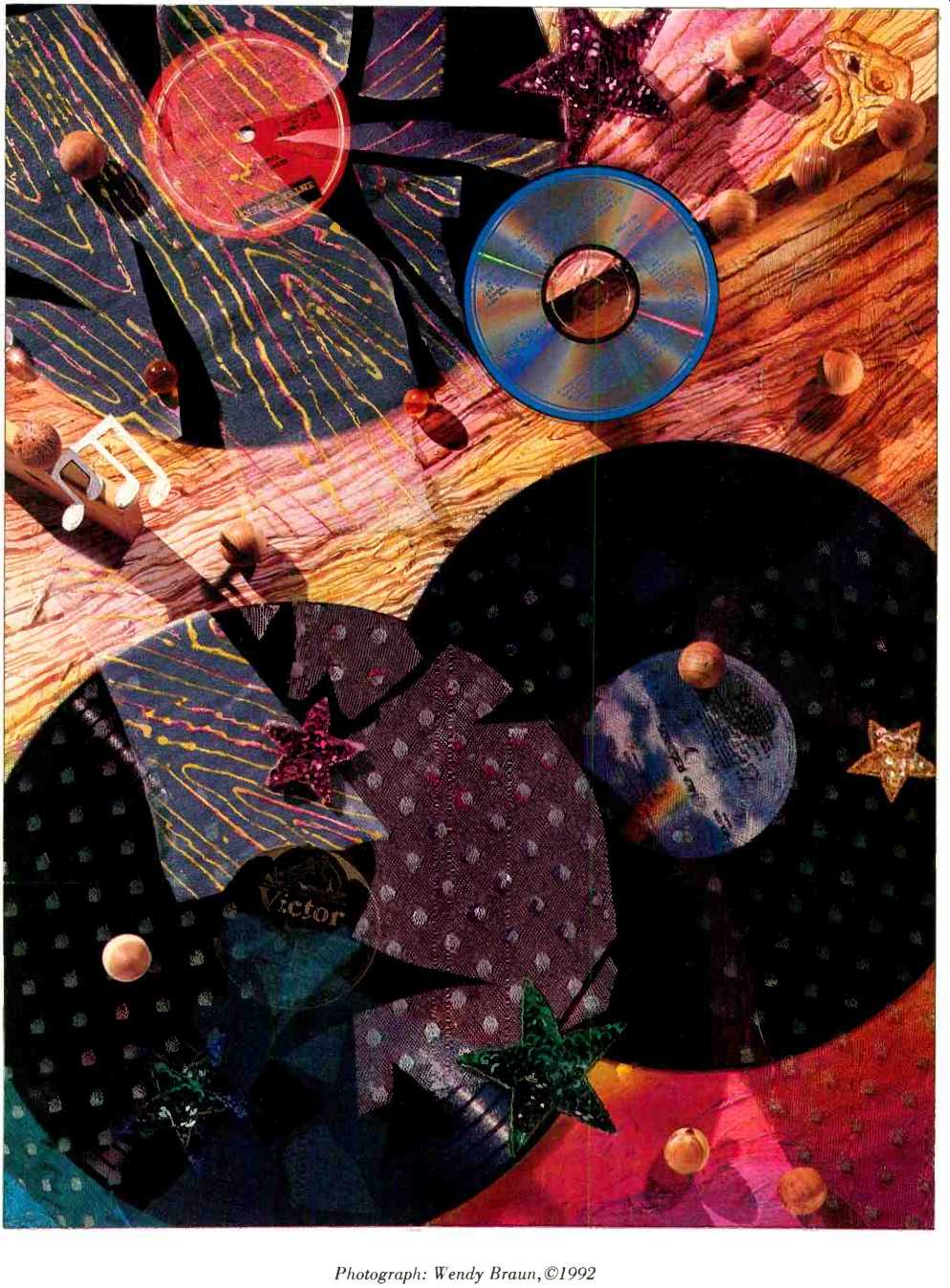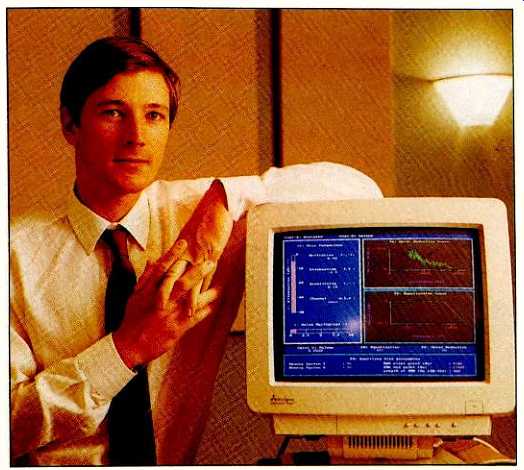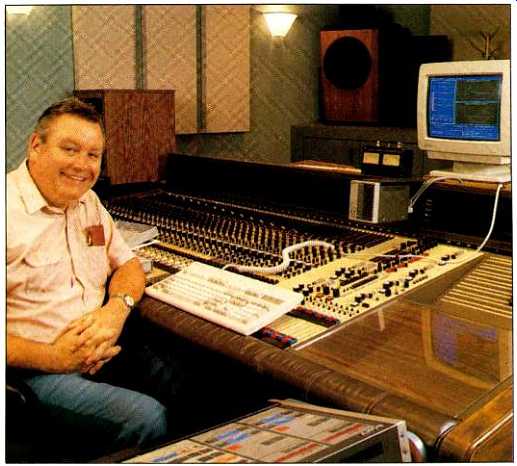
by
Beth C. Fishkind
The digital revolution cut through the audio field with a double-edged sword. On one side, the Compact Disc provided a wide dynamic range and a silence-is-golden backdrop to the music. On the other side, these benefits exposed a great deal of noise on some old recordings re-mastered for CD. Pop, click, hiss, hum, buzz, and other manner of onomatopoeic characters swelled the ranks of foes that remastering engineers and producers battle.
But if digital technology caused problems, it's proving it can solve them too. Since the late 1980s, digital signal processing (DSP) techniques have enabled engineers and producers to re store old analog recordings that would otherwise be unlistenable. The first system to gain wide acceptance was NoNoise from San Francisco-based Sonic Solutions (see "Putting the Byte on Noise," March '89). Using high speed computers, sophisticated DSP software, and an assist from a helping human hand, NoNoise removes sonic imperfections on media ranging from old recordings to film soundtracks.
Some of the recordings processed with NoNoise include The Doors' Live at Hollywood Bowl (Elektra 60741-2), Andres Segovia's The Segovia Collection, Vols. 2 and 3 (MCA Classics MCAD-42067 and MCAD-42069), and Louis Armstrong's Pops: The 1940s Small-Band Sides (Bluebird 6378-2-RB).
Challenging NoNoise's dominance is a newer system called Computer Enhanced Digital Audio Restoration, or CEDAR, from CEDAR Audio Ltd. in Cambridge, England. Though the NoNoise and CEDAR setups are similar, CEDAR's developers say their system features a more advanced generation of DSP that makes it more effective as well as quicker and easier to use.
CEDAR has been fast gaining acceptance since the technology became available in 1989, initially as a remote studio to which clients would send work, then as are in-house system.
Hundreds of recordings have been processed with CEDAR. Sony Music has used the system for many titles in its Roots 'n' Blues and Jazz Legacy series. BMG uses CEDAR for various reissues on Bluebird and RCA as well as for a lot of outside work, such as the Glenn Miller disc in Time-Life's Big Band series and reissues of Bing Crosby and Frank Sinatra through Reader's Digest. PolyGram has also used CE- DAR to clean up a number of Eric Clapton tracks.
CEDAR operates entirely in the digital domain, so first the source recording must be transferred to a digital recording system, such as the Sony 1630. Then, a unit made by Harmonia Mundi Acustica, for example, converts the source to the AES/EBU digital signal that CEDAR requires for "talking" to the Sony or other recorder.
With the source prepared, CEDAR begins the first step to reduce noise: De-clicking. Here, a module in the CEDAR system removes clicks, pops, and other big impulsive noises.
Because the system operates in real time, the signal passes through the module as if going through a compressor, reverb box, or some other piece of out board gear, with instantaneous results. An upgraded version of the de-clicking module, introduced at the AES convention last fall in New York, checks the source up to four times for sonic imperfections-still in real time.
When this layer of coarse noise is gone, an underlying layer of crackle is often revealed. This is subjected to de-crackling, distinguished from de-clicking be cause the two types of noise aren't the same, according to Gordon Reid, general manager for CEDAR Audio. "If you put a waveform on the computer screen," he explains, "you can see the clicks [of the first layer of noise] very obviously-the little spikes and so forth-but crackle is completely invisible to the human eye." Because this layer is so difficult to detect, de-crack ling involves a two-step process, per formed by a separate module called a splitter/re-combiner. First, the source is split into two-signal without noise versus all the noise and a tiny portion of signal. Only the latter half, noise with a bit of signal, is treated before the two sections are recombined.
The source is split as a precaution against mistaking a high-frequency transient for a tick of noise, since de-crackling involves adjusting the CE DAR system's sensitivity to magnify as many ticks as possible. For instance, the waveform of a screech trumpet, popular in jazz back in the '20s and '30s, could easily be mistaken for that of a series of little ticks, notes Jerry Graham, eastern sales manager at Gotham Audio in Manhattan, CEDAR Audio's U.S. sales agent.
After de-clicking and de-crackling, what's next is de-noising, the removal of such broadband noise as hiss, hum, and buzz. This first requires identifying whether the type of noise to be re moved is from room rumble, tape hiss, media deterioration of a 78-rpm recording, or some other problem. Then CEDAR takes a sample (about 1/40th of a second) of the noise minus the signal, e.g., before the music begins or during a pause. This sample is captured in a noise-reduction curve (NRC), which is then viewed in a spectral display to see where music is--or, rather, isn't. The NRC is then modified to process or eliminate unwanted sounds between any two particular frequencies, or wherever else the user wishes. When a sample isn't available, the user can define and create an NRC based on prior experience.
To tackle other problems, CEDAR also features a 512-node equalizer, which combines all manner of equalization, including parametric, graphic, bandpass, and band reject. The EQ can be used with the de-noising module or as a stand-alone. When used on its own for cutting frequencies, it operates similarly to a typical EQ: It cuts back the noise and the signal equally, which is the desired effect. For boosting frequencies, however, Reid points out that CEDAR's EQ provides "noise-free equalization," which boosts just the signal, not the noise.
===========

The CEDAR system lives in a personal computer, as demonstrated here by Keith Millar, who is a development engineer for CEDAR Audio.
===========
"This doesn't mean that the equalizer doesn't introduce extra noise," Reid qualifies. "It means that if you've got a noise envelope you want to maintain for realism or whatever, and you want to boost part of the signal, you can do that without creating enormous noise levels, because CEDAR boosts only the signal portion of the overall source recording." The full CEDAR system lives in an IBM-compatible personal computer.
However, CEDAR Audio, in conjunction with Harmonia Mundi Acustica (HMA) and Daniel Weiss Engineering of Switzerland, has developed a real time de-clicking unit for use with the HMA Model bw102 system. Two CEDAR/HMA units are needed for stereo operation. An independent, fully-auto mated rack-mount version is also planned.
========
The de-clicking step removes big pops, de-crackling attacks the very fine layer underneath them, and de-noising goes after broadband hiss.
========
The CEDAR/HMA unit, which made its debut in January '91, was a world first. But last summer, Sonic Solutions not only bowed its own real-time de-clicking option for its NoNoise system but also beat out CEDAR Audio in offering a real-time de-crackling module.
Sonic Solutions says its new algorithm eliminates both clicks and the leftover crackle in just one pass. CEDAR Audio introduced its real-time de-crackling module last fall. Thus, CEDAR and NoNoise are neck and neck in an on going race for advancements in eliminating noise. "Whatever X does, Y tries to implement as best they can," says Gotham Audio's Graham.
Despite offering the same end result of removing sonic impurities, CEDAR and NoNoise are actually conceptually different, Reid explains.
NoNoise is an expansion of Sonic Solutions' editor, he points out, and less than 25% of Sonic Solutions' equipment marketed actually has NoNoise. On the other hand, CEDAR Audio's primary intention its focus of research and development-has always been noise removal. Yet in response to customer re quests, CEDAR Audio is working on an editor that will, in its final incarnation, have both full EQ and SMPTE control of all the CEDAR modules. The editor was expected to be available early this year.
Other CEDAR add-ons in development are a sampling-rate converter, a one-pass real-time compilation or assembly editor (as opposed to a wave form editor), and a real-time fast Fourier transform (FFT) in two or three dimensions with color and a resolution of 8,192 points (compared with the usual 500 or 1,000 points). CEDAR Audio says the FFT-more powerful than a spectral display-enables users to see which parts of the signal are music and which are noise, and it can show the effects of EQ on real music, not just on sine waves. A stereo phase-corrector module is also on the way, able to correct imperfections caused by recording-head misalignment. When used with mono recordings on vinyl, the phase-corrector module will also help engineers and producers deter mine the less noisy groove wall from which to take the source.
The NoNoise and CEDAR systems do pretty much the same thing in the same sequence: De-clicking, de-crackling, de-noising. Used with proper skill, the two systems can produce equally good results. The differences lie in how each system performs these tasks--and in the degree of difficulty for the system operator. CEDAR's developers do not want to force a recording engineer into becoming a computer engineer. "We want somebody who understands a compressor, a chorus unit, or something like that to be able to operate CEDAR without any great difficulty," Reid says.
CEDAR has a "point and shoot" friendliness because of AT&T's DSP32C chip, a high-throughput screamer straight from Bell Labs. (The DSP32C is also used in Patriot missiles, famous in the Gulf War for intercepting Iraqi SCUDs.) The chip operates special algorithms that snare the sonic imperfections around the signal waveform in a manner different from the NoNoise technique, providing better detection of pops and ticks and actually automating the removal process, claims Keith Millar, a development engineer for CEDAR Audio.
These algorithms were originally developed in a Cambridge University engineering lab, whose main professor, Peter Raynor, is director of CEDAR Audio.
The lab continues to advise the company on scratch algorithms.
CEDAR and NoNoise also differ in the removal of broadband noise. NoNoise takes a noise profile, or "fingerprint," that remains constant, whereas CEDAR continuously adapts to changes in noise. "The fingerprinting method is absolutely super for some material, a total disaster for others, and every shade in between," Reid says. He explains that a noise fingerprint works beautifully for light hiss on a modern master tape from the '50s or '60s, where tape hiss is fairly constant, but the method falls short on something like a 78 or a very early tape. "The very thing that makes noise noise is that it is spastic-a random statistical process," Reid notes. And the fingerprint is only truly accurate at the exact moment it was taken. "A hundredth of a second later let alone a hundred seconds later--it's wrong," he says. "It's kind of, sort of, right on the average, but it's wrong." The result is that at some frequencies, not enough noise is taken away; at other frequencies, too much noise is removed. "And what happens when you take away too much noise is, of course, you start eating into the signal." So now does CEDAR prevent this problem? Its method is to recalculate how much noise needs to be removed on a moment-by-moment basis. First, the user defines the parameters of the noise. Then, 44 times per second, CE DAR recalculates that profile. "We've given the system the ability to track the noise within certain limits," Reid says.
"Though, if you make the limits too wide, it can do some fairly wild things." These "fairly wild things" are the side effects of over-processing and the reason why CEDAR-like NoNoise requires operator skill during the de-noising stage. "What the computer can do is this constant updating and judgment of what the noise is, but what proportion of that to take away is still very much a question for a skilled audio engineer," Reid says. "But, of course, being real time, it's just like sitting at a mixing desk." If things don't sound right, all the operator needs to do is move the slider up and down until it's right; everything else is done by the computer. By manipulating two thermometer-style bar-graph controls, Reid explains, the CEDAR operator can create the conditions for removing the noise without damaging the signal.
But CEDAR Audio's engineers haven't been able to devise a way to get the computer to judge how much noise should be removed.
Overprocessing with NoNoise can produce what some describe as a "pumping" sound. Though CEDAR avoids that, it does have its idiosyncrasies, ac cording to Paul Brizzi, a BMG recording engineer.
"You can't say it's overprocessed," he explains, "but you can't say it's real. Voices will start to sound disembodied and mechanical." He also notes that the CEDAR computer can introduce low-frequency artifacts as a result of over-processing. Another side effect is "twittering," which he perceives as noise reduction reacting source.
"The real test," Brizzi says, "is to get rid of hiss without having all that hap pen. What has to be done is to continue tailoring the NRC and use the threshold controls too." The trick lies in the NRC's overall shape: A shape that works will match the signal, not the noise, with voice in particular being "devilishly hard to achieve," Brizzi adds. Experience and finesse help counter this challenge.
To avoid the side effects of over-processing and retain the ambience of the original recording, many engineers and producers favor leaving a little noise in. Paul Goodman, a veteran engineer with BMG and a three-time Grammy winner, notes that because he works with a lot of very old sources that are fairly noisy and ticky, such as big band recordings and metal masters, he doesn't expect the end result to be completely clean. "I don't want the music touched, so I'll accept a bit of noise," he says. "As long as the big thumps and grotzl are out." with the Larry Cohn, producer of the Roots 'n' Blues series for Sony Music, says he runs virtually everything he does through CEDAR. "It's absolutely top notch at de-clicking," he says. How ever, he doesn't find CEDAR effective for removing "swoosh" and abrasive noises from metal masters. "Maybe no system can do this?" he asks.
Cohn attributes some of his dissatisfaction to having had early work done by CEDAR Audio at its Cambridge studio. "The work needs our sensibility, not theirs," he says, underscoring the importance of the producer's role. "For things such as [correcting] low-end rumble, we really have to do that." Last summer, Sony Music purchased the de-clicking and de-crackling modules of the CEDAR system for in-house use.
Cohn is optimistic enough to predict that he'll see a 50% improvement in results.
Sony Music engineer Mark Wilder adds that while testing CEDAR's de-noising module, he and his colleagues detected some signal loss, which is why Sony initially didn't buy that portion of the system. However, he says Sony is now making the purchase owing to client pressure and because CEDAR Audio is refining the de-noising module. In addition, "You lose an ounce of signal but gain the benefit of ridding the source of some noise," he explains. "It's a better representation of what was going on at the original re cording."
===========

CEDAR developers stress ease of use; they do not want to force a recording engineer like Sony Music's Larry Keyes into becoming a computer engineer.
===========
CEDAR Audio recently began selling the de-clicking module to companies that restore old 78s and other media. So-called wooded 78s, named for the wooden needles that were once used to play them, can have as many as 2,500 scratches per second nested in their grooves. With a price tag of about $25,000, the de-clicking module isn't cheap, but it's certainly less expensive than the full system, which sells for a little over $100,000. And in many cases, the de-clicker is all that's needed. "Unless you're looking for extremely fine ticks that are deeply buried," says Gotham Audio's Jerry Graham, "the first de-clicking module is usually enough." One of CEDAR Audio's long-term goals is to make the system technology inexpensive enough to be attractive as a piece of high-end consumer audio equipment. Indeed, given later generations of powerful chips and matching software, CEDAR Audio would like to offer an off-the-shelf black box for audiophiles to play their old vinyl albums scratch-free. And if you ever grew nostalgic, you could just by pass your CEDAR unit for an antiquarian fest of pop, crackle, and buzz.
(source: Audio magazine, Mar. 1992)
Also see:
Putting the Byte on Noise--NoNoise from Sonic Solution (Mar. 1989)
= = = =